Equinor’s Grane platform in the North Sea. Photo: Elisabeth Sahl / ©Equinor
Duplex stainless steel possesses several properties – corrosion/erosion resistance, heat resistance, light weight, toughness and hardness – which, taken together, make it the material of choice in many applications. In this article we cite examples that illustrate its multi-purpose nature.
By James Chater
Duplex is not…
Duplex stainless steels do not rate highly in any list of superlatives. They score highly in terms of corrosion resistance and toughness, and only slightly less highly in terms of heat resistance; but they are not absolutely at the top of either list.
So, what is the most corrosion-resistant metal? The prize goes to iridium, a dense, brittle transition metal of the platinum group. Followers-up would include certain grades of stainless steel, aluminium, copper alloys and nickel alloys.
What is the most heat-resistant metal? This used to be tantalum carbide (melting point: 4,000° C), but recently it was pipped at the post by a new alloy, hafnium carbonitride (HfCN), a ceramic that melts at just over 4,000° C. For comparison, titanium melts at 1,668° C, duplex grade 2205 melts at 1,385–1,445° C, and super-duplex grades at around 1,410–1,460° C (comparable to nickel, 1,455° C).
And the strongest materials? Strength and toughness can be measured in various ways, but the strongest material of all is probably graphene (fracture strength is more than 125 GPa). The most impact-resistant metal is tungsten, with chromium, iron, titanium, vanadium and lutetium (a rare earth metal) all runners-up.
A supplier’s view
We asked Rodney Rice, director of Langley Alloys, to describe the market conditions of the last 12 months:
“We see continuing high demand for duplex, and specifically super duplex, with strong demand from oil & gas and a drive towards energy security. Although people may instantly think of upstream exploration and extraction, where these grades are widely used on account of their high performance at competitive cost, demand is also strong from downstream applications in the form of pump and valve components. Applications involving exposure to seawater (e.g. offshore wind power) have also been positive. Fasteners, across a broad range of markets, continue to be a strong application.
Water scarcity will continue to create demand for desalination, which consumes duplex and super duplex piping. Plate applications include mining, but also hydrothermal power and fertilizer production, both applications with strong growth potential.”
Duplex is…
Now, what is the material that combines all these properties (at least up to a point), is composed of widely available, affordable materials and is easy to fabricate? The answer, across a broad range of industries, would have to be duplex stainless steel. Taking all factors into consideration – resistance to heat, corrosion and erosion, strength, price, formability, recyclability and life-cycle costs – duplex grades combine all the necessary properties to an extent sufficient to make them competitive compared with other stainless grades, let alone carbon steel or other materials. This combination of properties can be illustrated by several examples.
Architecture: Fondation Louis Vuitton, Paris
When applying stainless steel, architects tend to favour austenitics 304 and 316, as this normally provides sufficient corrosion resistance. However, when weight savings or structural integrity are important, they will turn to duplex grades. This is what happened at the Fondation Louis Vuitton, Paris. Its bold, complex design, signed by Frank Gehry, has been compared to a ghost ship. Its main structure is surmounted by billowing glass “sails” supported by a grid made of 2205 duplex stainless steel. The wooden and steel components of the sails are joined by 540 duplex stainless-steel plates inserted into the wooden beams. This results in a weight saving of 30% compared with an equivalent structure in 316. Type 2205 is also applied for gutters, connectors and fasteners, tension rods and rails.
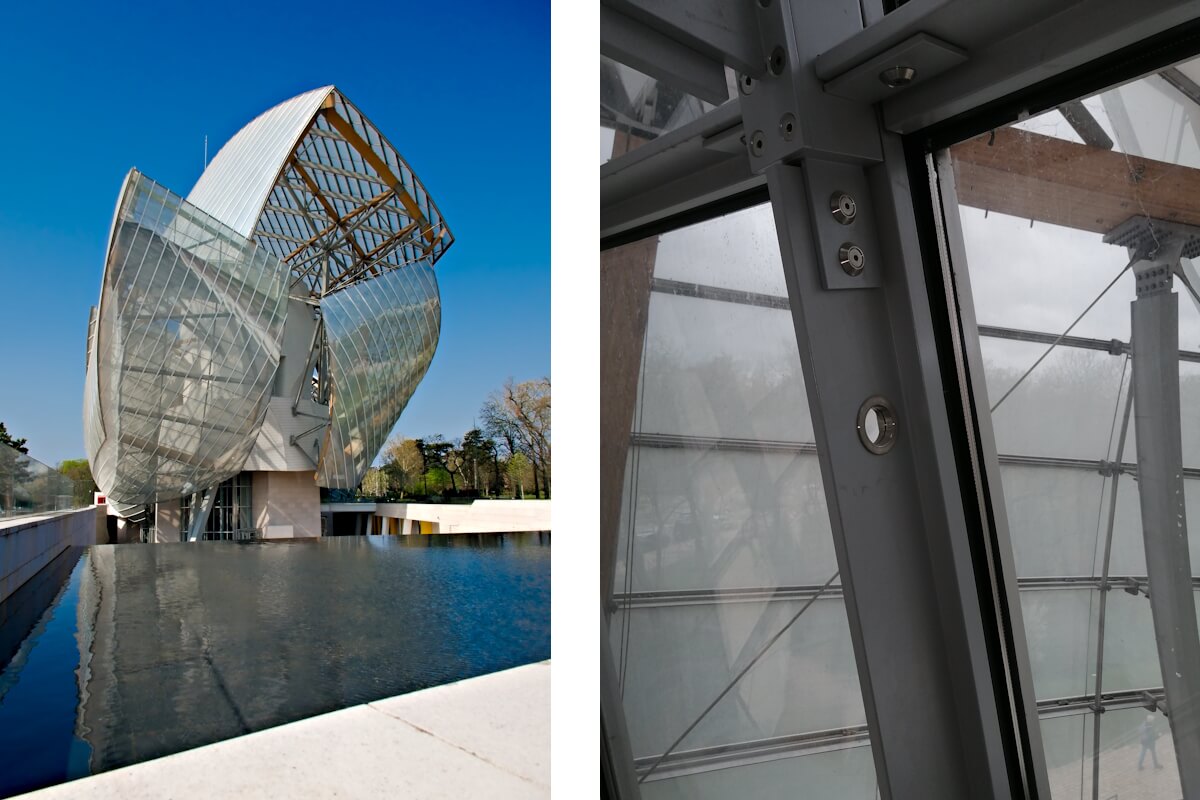
Deepwater oil & gas
Another example of corrosion resistance combined with mechanical strength can be found in deepwater oil & gas. Longitudinally-welded or seamless umbilicals, which bundle together the various lines (flowlines, power, data, water, chemicals, fluids, etc.) between subsea wells and the platform, often need to span long distances in deep water, so a material that can both resist corrosion and withstand high pressures is called for, such as super-duplex type 2507. Flexible pipes or risers, used to convey oil or gas from seabed to surface, also require high grades. Depending on the depth, super-austenitics, duplex in lean (2101), standard (2205) or super-austenitic (2507) grades are applied. Duplex is also finding use in valves that handle monoethylene glycol (MEG). This chemical is used to inhibit hydrate formation in pipelines, which can cause blockages. Recently Oliver Twinsafe supplied double block and bleed valves for the MEG injection pump systems of an offshore project, made of A182 F55 super-duplex stainless steel.
Marine installations
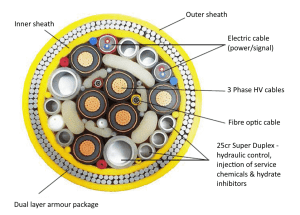
Oil & gas or wind platforms or solar power systems, being exposed to seawater, are environments where duplex grades are often applied. These have three types of environments: atmospheric, splash or submerged zones. Depending on the level of corrosivity, each can require duplex steels of varying strength. The most severe zone of all is the splash zone, where hazards include oxygen-rich seawater (chloride environment), wet-dry cycles and UV radiation. In addition, other challenges include powerful wind or underwater currents, cold and sea spray and sand abrasion. For all these reasons, standard or super-duplex grades are required; for the other two, lean grades can sometimes be enough.
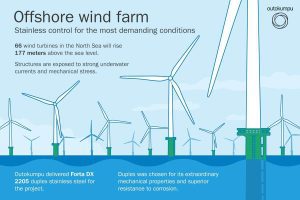
Recently, the Merkur offshore wind farm in the North Sea constructed the supports of the wind turbines using Outokumpa Forta 2205 duplex for its corrosion resistance, strength and flexibility. The turbine in question is the gigantic Heliade 150-6MW from GE, whose rotor has a diameter of 150 metres.
Offshore wind farms also require valves made in duplex stainless steel. Oliver Twinsafe supplied Modular and Monoflange double block and bleed valves for the largest offshore wind project in the world, Hornsea 3 in the North Sea. The materials used included 316, titanium and super-duplex. They were applied in cooling systems and firewater applications.
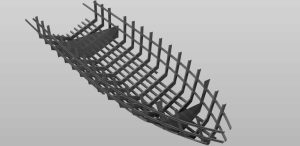
Another growing marine application is boats. A few years ago, Sweden’s Stainless Steel Yachts (SSY) built a sailing yacht from super-duplex 2507, combining excellent corrosion resistance with a weight saving of up to 50%, resulting in greater fuel economy. A polished hull reduced water friction and eliminated the need for anti-fouling paint. Since then, the same company has introduced a range of small boats, including, yachts and patrol boats, built from 2507 and hyper-duplex grade 3207. In both cases, the material was supplied by Alleima (then Sandvik). According to SSY, these grades are superior to two materials that are sometimes used on light vessels: aluminium, which fatigues more quickly, is sensitive to fire and is susceptible to galvanic corrosion; and carbon fibre, which cracks more easily, is non-recyclable and sensitive to fire. Once again, only duplex has all the essentials covered.
Wastewater and desalination
Desalination is an obvious area in which duplex grades are applied, because of the exposure to saltwater. But wastewater treatment is increasingly turning to duplex because of the need to resist both corrosion and erosion. Type 2205 is used in evaporators, piping systems, heat exchangers, tanks, valves and reactors. Recently Invest-Tech designed a new type of wastewater treatment storage tank built of Forta LDX 2101. This departs from the traditional round form because of the need to expand to accommodate increased capacity. Square or rectangular shapes are bolted together – though the process does require some welding. Therefore, apart from corrosion resistance, high pressure and weldability were important criteria.
Food storage
A few years ago, water or food storage tanks would have been manufactured entirely of austenitic grades 304 or 316; later, manufacturers favoured a combination of austenitics on top and duplex for the lower part, which is under greatest pressure. Now it has been realized that although duplex is more costly per tonne, the thinner walls translated into material savings, especially in thicknesses of over 6mm. This was the thinking behind GPI Tanks XL’s decision to use type 2205 to build the nine food storage tanks at Rotterdam for Maastank International.
Fertilizer
Fertilizer production is a growing market for super duplex grades. Their ability to resist phosphoric acids and abrasion mean they are the natural choice for agitators, tanks and other process units – readily fabricated from plates and bars for both new construction and maintenance. Rodney Rice, director of Langley Alloys, told us: “We have supplied our Ferralium 255 (S32550) grade to many projects. Applications include a very large agitator, fabricated from plate rather than using a solid bar shaft, together with bolted blades to allow their straightforward replacement. The ‘splitter box’ serves as a distribution point for phosphate (P2O5) solution coming from the evaporators (at 28%, 40%, and 50% acid concentrations respectively) going to primary storage tanks. Connectors, reducers, and other sections of process pipework were also produced in this grade. We also supply Ferralium 255 bar, sometimes with additional heat treatment processing, machining and inspection, to produce pumps and valves for new facilities.”

Paper & pulp
The whole spectrum of duplex properties – erosion/corrosion resistance in hot, alkaline, acidic and water environments, high mechanical strength and weldability come into play in the paper & pulp industry. Lean duplex grades work well in an alkaline environment, while for acidic conditions, standard or duplex grades are required for their superior stress corrosion cracking. Duplex is applied in the digester and associated equipment, bleaching equipment, Kraft liquor tanks and clarifiers. The superior corrosion/erosion resistance and strength of duplex allow strainer plates with more holes, greatly accelerating the process of filtering out the wood fibres from the cooking liquid. This is a clear example of how duplex scores over austenitic grades.
Waste to energy
Two obstacles in the way of a decarbonized planet are fossil fuel consumption and livestock emissions. Converting livestock manure into biomethane kills two birds with one stone. This is the thinking behind a series of biogas plants built by Weltec Biopower, of which the one in Granja La Carbona, near Lleida, Spain, is the most recent. The process of breaking down the waste to produce gas and heat, known as anaerobic digestion, requires a digester capable of handling highly corrosive substances (organic acids, hydrogen sulphide and chlorides). In this application, duplex stainless steel is standard.
Mining wagons
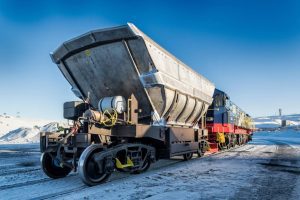
A cold environment, corrosion and cracked welds were some of the factors that determined the use of lean grade LDX 2101 to build 50 new mining wagons. Kiruna Wagons in the north of Sweden required a material stronger than carbon steel to make its mining wagons. Two-metre-wide cold-rolled coil made of LDX 2101 had the required strength and abrasion resistance. Since the ore had the tendency to stick to the carbon-steel walls, the duplex walls were polished to allow easier release, thereby saving time.
About this Featured Story
This Featured Story appeared in Stainless Steel World April 2024 magazine. To read many more articles like these on an (almost) monthly basis, subscribe to our magazine (available in print and digital format) – SUBSCRIPTIONS TO OUR DIGITAL VERSION ARE NOW FREE.
Every week we share a new Featured Story with our Stainless Steel community. Join us and let’s share your Featured Story on Stainless Steel World online and in print.


